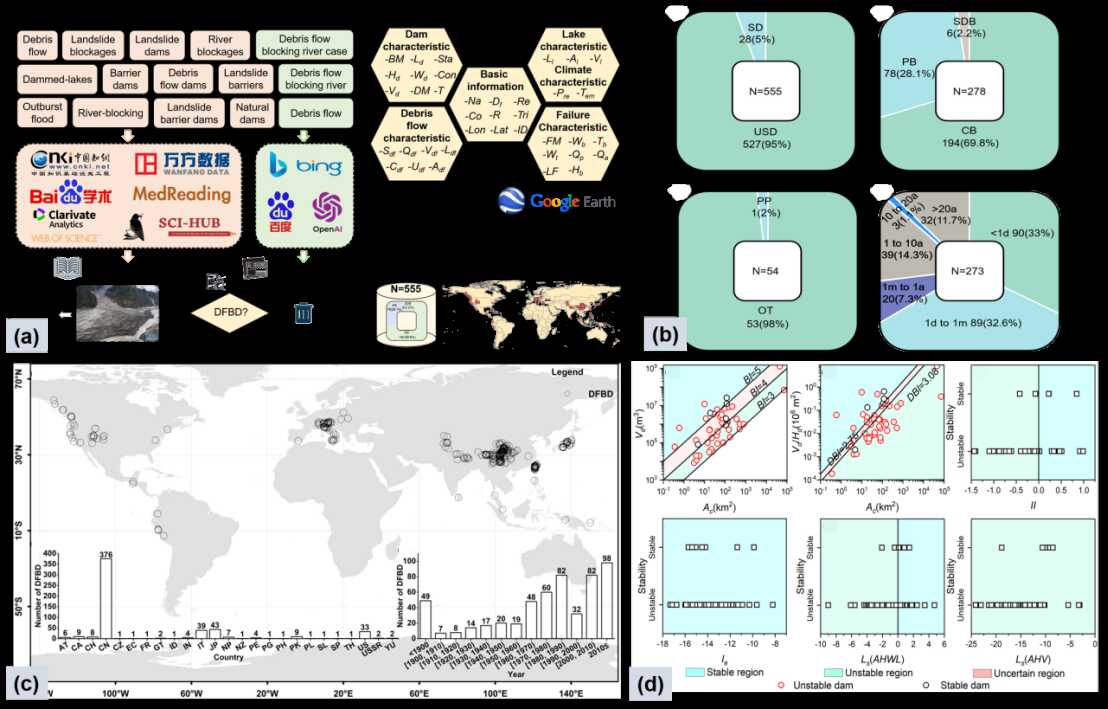Debris flow barrier dams (DFBDs) significantly alter hydro-geomorphic environment and can trigger cascading secondary hazards, particularly upstream impoundment and outburst floods. Field-measured data are crucial for understanding dam formation and evolution; however, prior research has primarily focused on isolated case studies, lacking systematic data integration and cross-case comparisons. This limitation severely hinders the prediction and mitigation of debris-flow damming disaster chains. To address this critical research gap, Prof. HU Kaiheng and his team employed a multi-source heterogeneous data fusion approach. The researchers conducted a systematic review of 2,519 high-quality literature and media reports, while cross-validating the compiled data with spatiotemporal information extracted from Google Earth imagery. This effort culminated in the first global, multi-dimensional dataset of DFBDs.
The dataset described the characteristics of DFBDs using 6 categories and 38 attributes, including basic information (latitude and longitude, etc.), debris flow characteristics (debris flow velocity, debris flow peak discharge, etc.), dam characteristics (dam height, dam volume, etc.), lake characteristics (lake area, lake volume, etc.), failure characteristics (peak discharge, loss of life, etc.), and climate characteristics (precipitation and temperature). Leveraging this dataset, the team revealed that DFBDs exhibit a high complete blockage rate of 69.8 %, and that 98 % of failures occur by overtopping. In addition, DFBDs tend to have relatively poor stability, with about 73 % of DFBDs failing within 1 year after formation. Repeated river-blocking events are common: 15 % of rivers experienced multiple debris flows, forming 192 DFBDs (35 % of the total). Concurrently, the team systematically evaluated the applicability limits of conventional landslide dam discharge and stability models when applied to DFBDs.
Open access to this dataset provides critical support for assessing debris-flow damming hazards, developing early-warning models, and designing mitigation measures. The research titled “A worldwide event-based debris flow barrier dam dataset from 1800 to 2023” has been published in Earth System Science Data (2024 IF:11.6), a TOP journal in the field of earth system sciences. This work was jointly supported by the Second Tibetan Plateau Scientific Expedition and Research Program (grant no. 2019QZKK0902), the Key R&D Program of Xizang Autonomous Region (grant no. XZ202301ZY0039G), the Sichuan Science and Technology Program (grant no. 2024YFFK0108), the National Natural Science Foundation of China (grant no. 52409109), and the Science and Technology Research Program of the Institute of Mountain Hazards and Environment, Chinese Academy of Sciences (grant no. IMHE-ZDRW-01).
Link: https://doi.org/10.5194/essd-17-1573-2025

Figure 1 (a) Procedure for the compilation of the dataset. (b) The stability, blockage modes, failure mechanisms, and longevity of DFBDs. (c) Worldwide DFBD spatiotemporal distribution. (d) Stability calculation results (Image by HU Kaiheng).
Contact:
Prof. HU Kaiheng
Intitute of Mountain Hazards and Environment, Chinese Academy of Sciences
Chengdu, Sichuan, 610213, China
E-mail: khhu@imde.ac.cn
